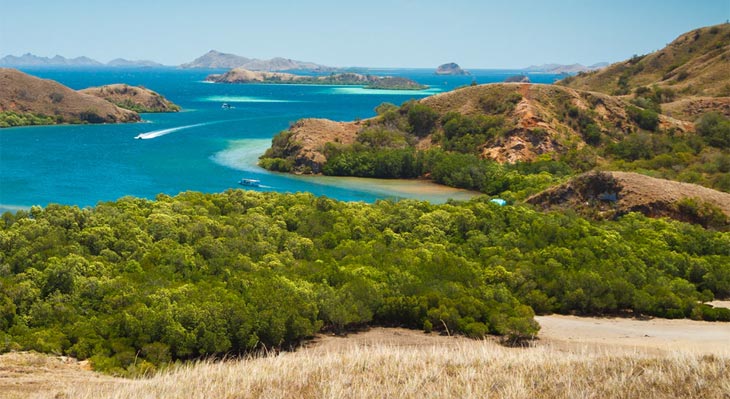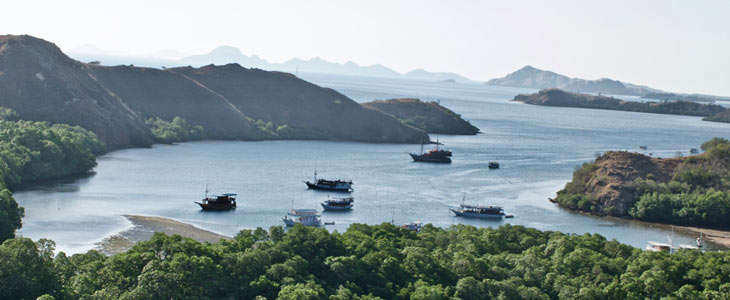Komodo National Park is a must visit national park for tourists in Indonesia. Explore a detailed tourist guide about Komodo National Park - a world heritage site in Indonesia.
Komodo National Park
Komodo National Park - Wilderness beckons the wild at hearts and nature at Komodo National Park stands ready to thrill with its mystery and aura. The name Komodo National Park is synonymous to the feel of extreme adventure and thrill. The wilderness of the Park is infested with some veritable primordial beasts that can set the adrenalin pumping hard. Such a destination is a traveller’s ultimate fantasy. Set foot on this park to unravel some of the world’s greatest mysteries and ancient secrets.
Come visit the heart of Indonesian archipelago to have a tryst with natural bounty. Indonesia offers you the chance to get lost in one of the most exotic destination where you can watch nature’s enigma haunting you through its legendary Komodo Dragons. Experience the spine-chilling thrill of a close encounter with this mighty and ferocious carnivore. Watch them hunt and prowl from a distance. Track their movement and watch them kill. Live the fantasy of your life. Get back to the prehistoric Jurassic era.

These giant lizards grow about three metres in length and weigh about 70 kgs on an average. They are the last ones left on this earth to remind you of the Jurassic era. They scour with abandon amidst the grasslands captivating the travellers with their ferocity, massive sizes, flat heads, bowed legs, long thick tails and fork-shaped tongues.
Komodo National Park, featured as one of the World's Top Ten Destinations by the National Geographic magazine in their special issue on the '100 Best Destinations around the world in four seasons' July 2017 edition, is located in East Nusa Tenggara, Indonesia. This island is uniquely blessed by nature to leave you awed and thirsty for more.
Flora and fauna
Experience the unique charm of rugged hill slopes and sultry aridness of dry savannah with sporadic patches of green thorny vegetation. And keep your sense alert for the camouflaged giant lizards, aggressive and foraging. The 5,700 odd humongous stealthy lizards will keep you rivetted to the green and brown of the island. The aridness will give way to the soothing white of the beach sands and lapping blueness of the washing waves with mesmerizing iridescence of the happy corals.
The island awaits to greet you with 12 snake species, 9 lizard species, frogs, the Timor deer, the primary food of the Komodo, horses, water buffalos, wild boars, Rinca rat, fruit bats, and scrub fowl co-existing with more than over 40 species of feathered friends. Delve into the mysterious vestiges of the ocean folds to watch the myriad variety of 1,000 species of different fish, overwhelming 260 species of reef-building coral and beguiling 70 species of sponges. Dive with the legendary dugong, sharks, manta rays, whales, dolphins and sea turtles only in Komodo National Park among the succulent coral reefs, mangroves, seagrass beds, seamounts along the protected coves and semi-enclosed bays.
Climate and Weather
The climate of the Komodo National Park is dry in nature. In fact, the park occupies one of the most arid regions of Indonesia. The national park remains dry and without rainfall for about eight months. Most of the rainfall comes in the monsoon season. In the dry months, temperatures in the park record an average of 40 degrees, between May and October. The rainy season falls between January and March with average temperature varying around 30 degrees. July and August are the coolest months of the year blessed with rain showers.
Due to scanty rainfall, the region sees vegetation limited to grass, shrubs, orchids and some varieties of trees. This kind of vegetation is suitable for nurturing the fiercest of lizard species. Around 5,700 giant Komodo dragons have chosen this land to be their foraging ground. The rugged hills and stony belts of dry savannah grasses and thorny bushes pose a stark contrast to the brilliant white sandy beaches and the blue waters of Asia Pacific Coral Triangle. The coastal waters harbour a medley of seagrass beds, shimmering coral reefs and dense mangrove forests.
Top most attractions of Komodo National Park:
1 - Tete-a-tete with the primordial and fierce Komodo Dragons on Rinca Island

The Komodo National Park has been conceptualized to protect the fearsome and unique Komodo dragon, known to be the world's largest lizard species. The national park was declared a UNESCO World Heritage Site in the year 1991. Komodo National Park occupies a position among the New7Wonders of Nature.
Rinca Island is ideal for a tryst with the legendary Komodo Dragon. The dock of KohKima and the campsite of LohBuaya are famous for Komodo spotting. A trek across the dense forests of the island will reveal the mysteries and break the myths associated with Komodo Dragons. Sighting of other interesting animals such as wild water buffalos, Timor deer, wild horses and tropical birds form added visual treats.
2 - Soak the sea and sand on the Pink Beach of Komodo Island

The Pink Beach of Komodo Island has a rich legacy being one of just seven beaches in the world to have sands of a shade of soft pink. The red corals fringing the shores combine with the white sands to lend this pink hue that gives the beach its name. Also known as PantaiMerah, the beach forms a breath-taking view contrasting with the eternal green hills. The turquoise blue waters lapping up the luminous pink sands create magic together with the azure blue skies and leave you breathless. Dive and snorkel at peace and explore the underwater splendour of an enigmatic and wondrous flora and fauna.
3 - The picturesque Padar Island hiking
Padar Island, also known as GiliPadar, has an amazingly beautiful landscape. It is the third largest island in Komodo National Park. This uninhabited island is a perfect place for a scenic hike and spectacular photo shooting. Up the grassy hills get wind swept with your eyes resting on the surrounding greenery and feasting on the soothing white and blue hues of the clear skies and oceans. The tallest peak in the island offers a spectacular view of the four crescent-shaped sandy beaches.
4 - Explore the photogenic Gili Lawa Darat Island
This uninhabited dry savannah island offers a unique underwater charisma along its coasts. The view of the sunset and sunrise is absolutely bewitching from the top of the hills located in the island. The island is a hotspot for curious divers waiting to explore the scintillating ocean world.
